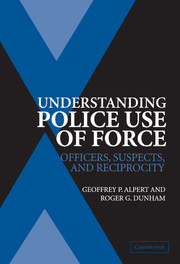Book contents
- Frontmatter
- Contents
- Acknowledgments
- Introduction: The Context of Police Use of Force
- 1 Police Use of Force: The History of Research
- 2 The Crucial Element: Finding Research Sites
- 3 Findings from Miami-Dade Police Department Study
- 4 The Sequential Steps in Use-of-Force Incidents in the Miami-Dade Police Department
- 5 Miami-Dade Police Department: Inconsistencies between Officer and Suspect Accounts of the Use of Force
- 6 Findings from Prince George's County Police Department
- 7 Findings and Summary
- 8 Explaining Police Use of Force: The Breakdown of an Authority Maintenance Ritual
- Appendix: Frequencies of Force Sequences for First through Tenth Actions
- Index
- References
8 - Explaining Police Use of Force: The Breakdown of an Authority Maintenance Ritual
Published online by Cambridge University Press: 14 July 2009
- Frontmatter
- Contents
- Acknowledgments
- Introduction: The Context of Police Use of Force
- 1 Police Use of Force: The History of Research
- 2 The Crucial Element: Finding Research Sites
- 3 Findings from Miami-Dade Police Department Study
- 4 The Sequential Steps in Use-of-Force Incidents in the Miami-Dade Police Department
- 5 Miami-Dade Police Department: Inconsistencies between Officer and Suspect Accounts of the Use of Force
- 6 Findings from Prince George's County Police Department
- 7 Findings and Summary
- 8 Explaining Police Use of Force: The Breakdown of an Authority Maintenance Ritual
- Appendix: Frequencies of Force Sequences for First through Tenth Actions
- Index
- References
Summary
The central meaning of police authority is its significance as a mechanism for “managing” relationships.
(Reiss and Bordua, 1967:25)the purpose of this chapter is to propose a broad conceptual and theoretical construct to enhance our understanding of what we know about police use of force. In addition, the constructs we present can be used to direct future research on police use of force. The results of the cumulative methodological and substantive advancements in research on police use of force outlined in previous chapters provide the backdrop for the development of our theoretical framework.
Methodological progress is evident as researchers have shifted their focus from relying on personal narratives of independent observers (many of whom were involved in the police–citizen encounters) to representative data collected from official records and systematic observations. The assessment of police use of force has evolved from dichotomous measures of force or nonuse of force, to measures of levels of force, and finally to interactive measures taking into account both police use of force and citizen resistance within a sequence of connected actions and reactions.
Substantively, much has been learned about use-of-force incidents. Early studies were descriptive, detailing the amount, the degree, and the types of force used, as well as how the use of force differed in various types of incidents. Later, during the 1980s, more information became available on factors associated with using force and the different types of force, including various categorizations of individuals and situations.
- Type
- Chapter
- Information
- Understanding Police Use of ForceOfficers, Suspects, and Reciprocity, pp. 170 - 187Publisher: Cambridge University PressPrint publication year: 2004
References
- 5
- Cited by



